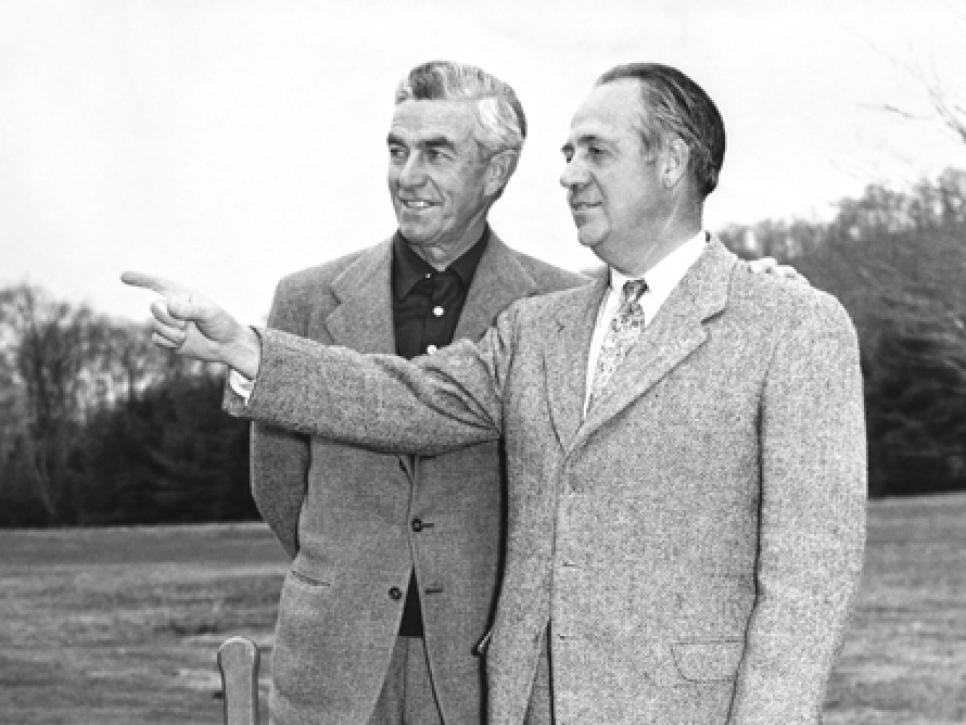The Loop
Compelling new book on Robert Trent Jones reveals the genius and complexity of late architect
By Ron Whitten
Most books about golf course architecture are lush coffee table volumes full of glossy calendar-art photographs. The texts are invariably gushy with praise, particularly if the subject is a long-departed demigod of the design game like Donald Ross, Alister MacKenzie or C.B. Macdonald, with little objectivity since the object is always to promote the architect and his art. I should know. I once wrote a book like that on designer Joe Lee.

A Difficult Par (Gotham Books, 2014, $32.50), the new biography on legendary golf architect Robert Trent Jones, is not that kind of book. It's thick, nearly 500 pages, with the only color photography being a shot of Spyglass Hill on the dust jacket. The text is full of facts not fluff. Those looking for yardage book-style descriptions of the global layouts of Trent Jones will be disappointed. Those looking for a rich examination of the seven-decade career of one of the game's most important figures will be rewarded.
The book does touch on the Trent Jones style of design. Indeed, the title refers to Trent's basic philosophy that golf should be a "hard par, easy bogey." But the book doesn't dwell on course design.
Not for lack of interest on the part of the author, James R. Hansen, who certainly knows golf. He captained his college golf team and has served for nearly two decades as a course rating panelist for the publication Golfweek. But Hansen is also a scholar, a professor of history at Auburn University and author of a previous biography on astronaut Neil Armstrong. Hansen obviously recognized there was a far more compelling story regarding Trent Jones than just describing his work. He dug deep for information in the business and personal papers of Trent Jones, which are now stored in the Cornell University archives, and prodded hard in interviews and correspondence with Trent's family and associates.
The tale Hansen weaves in A Difficult Par is in many ways astonishing. Jones was a high school dropout who still managed to take classes at Cornell in the 1920s to prepare himself to become the greatest golf architect in the world. He invented his middle name to distinguish himself from champion golfer Robert Tyre Jones Jr. He married a young woman, Ione Tefft Davis, who had far more business savvy than he and kept his design business solvent for decades. He cultivated friendships with the rich and famous and capitalized on them. He garnered publicity by becoming the architect pros loved to hated. He made foolish investments, especially after the death of his wife, that nearly bankrupted him. Late in his life, he was rescued from professional obscurity and financial oblivion by the head of the Retirement Systems of Alabama, who hired his company to create nearly overnight a 20-course tourist attraction called the Robert Trent Jones Golf Trail.

Jones with Johnny Farrell in 1954. Photo by Getty Images
Every detail is there, from the intimate love letters between Trent and Ione before their marriage to the cold calculated letter of dismissal sent to long-time design associate Roger Rulewich in late 1995, just after Rulewich had completed the Trent Jones Trail.
Hansen clearly had the cooperation of Trent's two sons, Robert Trent Jones Jr. and Rees Jones, both hugely successful golf architects on their own. But that didn't keep him from revealing what are probably some of the worst-kept secrets in golf design, that the Jones boys feuded early and often and engaged in something of a tug-of-war for their father's attention and affection. Between the two sons, Bobby comes off as the more calculating, trying in the early 1970s to convince potential clients that he was THE Robert Trent Jones, later muscling in on one of his father's proudest moments - creation of the first golf course in Russia - and ultimately orchestrating the closure of his father's firm in the 1990s. (Hansen implies that Bobby, not Trent, penned the termination letter to Rulewich.)
Rees has his flaws documented, too. Perhaps the most curious is his reaction to some of his father's designs. After establishing his reputation by the restoration of The Country Club for the 1988 U. S. Open, Rees proceeded to remodel, not restore, a number of his father's designs for subsequent major championships.
While the dysfunction of the Jones family is a considerable (some might say juicy) part of the book, its purpose is to emphasize what I think is the overriding theme: Robert Trent Jones made golf course design into a genuine profession. He was part P.T. Barnum, part Alfred Hitchcock. Once successful, Trent was more interested in signing the next deal than completing the last job. Indeed, in their early years in the business, both Bobby and Rees handled entire jobs credited to their father. Later, Trent's associates like Rulewich and Cabell Robinson would ghost-author courses that looked and played like Robert Trent Jones designs and bore the Trent Jones designer label. Trent never once got on a bulldozer to shape a feature himself, because he wanted to be perceived as a captain of industry, not part of the working class.
Some present-day golf architecture fans might scoff at the Trent Jones legacy, but without it, their heroes, from Pete Dye and Jack Nicklaus to Bill Coore and Ben Crenshaw, Tom Doak and Gil Hanse, would probably not be in the profession. Trent made it an important and lucrative business in the first place. Indeed, Hansen subtitled his book, Robert Trent Jones and The Making of Modern Golf.
Let's not fool ourselves. Even Doak and Hanse are busy these days chasing down the next job, leaving others to handle the day-to-day completion of some courses. They just retain tighter supervision over the work than Trent often did.
If you have any passion for golf design, A Difficult Par should be the next book you read on the subject. It puts so much into perspective.

